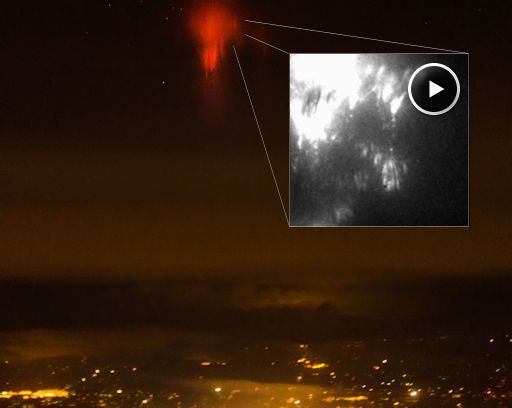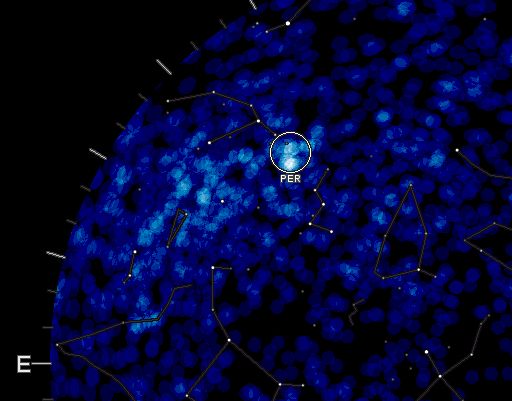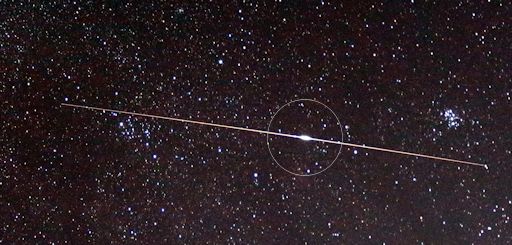They came from outer space--and you can have one! Genuine meteorites are now on sale in the Space Weather Store. | | |
MAGNETIC FIELD REVERSAL ON THE SUN: It hasn't happened yet, but it's about to. Data from NASA-supported observatories show that the sun's global magnetic field will flip before the end of 2013. The reversal, which signals the arrival of Solar Maximum, will have ripple effects felt throughout the solar system. Get the full story and a video from Science@NASA. Solar flare alerts: text, voice.
SPRITES AND JETS OVER OKLAHOMA CITY: High above Earth in the realm of meteors and noctilucent clouds, a strange form of lightning dances at the edge of space. Researchers call the bolts "sprites," and they are as beautiful as they are mysterious. Jason Ahrns, a graduate student from the University of Alaska Fairbanks, photographed a cluster of bright red sprites over Oklahoma City on August 6th. Click on the arrow to view a rare high-speed movie of the phenomenon:

"I normally study auroras," says Ahrns, "but I've become involved in sprites as a side interest." At the time of the photo, Ahrns was flying onboard a Gulfstream V operated by the National Center for Atmospheric Research (NCAR). "We try to get off to the side of sprite-producing storms, ideally about 200 km away, and film them with a couple of Phantom cameras running at 10,000 frames per second. One of the Phantoms has a diffraction grating in front of it to capture high speed spectra, which I don't think has ever been done before."
"We've also managed to record a few sprites over a lightning mapping array so we can identify the exact lightning strike that caused the sprite," he continues. "This has also never done before, and should provide insight into what type of lightning causes sprites."
"Lately," says Ahrns, "I've begun slipping my personal camera into a spare window of the airplane, and the results have been so impressive that we're planning to make a dSLR (digital camera) a regular part of future campaigns. On August 3rd I recorded some blue jets over Oklahoma city; I believe these are the first blue jets recorded by an ordinary dSLR." More tales of sprite-chasing may be found on Ahrns' personal blog.
Realtime Space Weather Photo Gallery
METEOR RADAR: The Canadian Meteor Orbit Radar (CMOR) is scanning the skies over North America for signs of meteor activity. This all-sky map produced during the early hours of August 8th shows a clustering of echoes in the constellation Perseus:

The meteors CMOR is detecting come from Comet 109P/Swift-Tuttle, source of the annual Perseid meteor shower. Earth is entering Swift-Tuttle's debris stream and Perseid activity is picking up. Forecasters expect the shower to peak on August 12-13 with as many as 100 meteors per hour. Be alert for fireballs!
Realtime Meteor Photo Gallery
JAPANESE SPACESHIP FLARES: Launched on August 3rd, Japan's unmanned HTV-4 cargo carrier is now chasing the International Space Station around Earth. The two spaceships will rendevous on Friday, August 9th. Meanwhile, skywatchers are enjoying the chase. Gary of Fort Davis, Texas, witnessed a bright flare from the Japanese ship when it flew over his home town two nights ago:

"Hello Kirobo!" says Gary, addressing the talking robot onboard the HTV-4. "I captured a nice flare as the resupply vessel passed thru Perseus and the Pleiades on Aug. 5th, 2013 at 05:57am. About 12 minutes earlier the ISS had passed thru the same area."
The flare from HTV-4 was caused by sunlight glinting off a flat surface, much like an Iridium flare. No one can predict HTV-4 flares, so every sighting is a surprise.
The next two nights are a great time to see two spaceships in the sky at the same time as the ISS and HTV-4 converge for docking. Download the Satellite Flybys App to turn your smartphone into a field-tested HTV-4 tracker! Flyby predictions are also available here.
Realtime Space Weather Photo Gallery
Realtime Aurora Photo Gallery
Realtime Noctilucent Cloud Photo Gallery
[previous years: 2003, 2004, 2005, 2006, 2007, 2008, 2009, 2011]
Realtime Comet Photo Gallery

